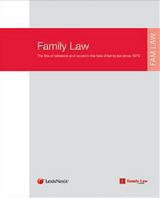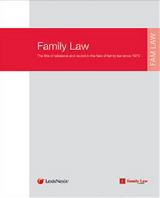- News & Comment
-
Online Shop
Online Services
Looseleafs
Law Reports
Books and eBooks
-
CPD & Events
Webinars
Events
- Authors
- About Family Law
- Contact












 10 MAR 2025
10 MAR 2025

 10 MAR 2025
10 MAR 2025

 10 MAR 2025
10 MAR 2025

 10 MAR 2025
10 MAR 2025

 10 MAR 2025
10 MAR 2025





![What’s in a shared care ‘label’? Reflections from AZ v BX [2024] EWHC 1528 (Fam)](https://www.familylaw.co.uk/images/venue_image/flj_journal-cover-image.tmb-moblatest.jpg?sfvrsn=fc885076_1)

Although there has been much reform of the processes and procedures in the family justice system in recent years, there is one area in which little has been done and much needs to be done: financial remedies. This is the Cinderella of family justice. Some of its failings were exposed by the Law Commission in its 2014 report, ‘Matrimonial Property, Needs and Agreements’, Law Com No 343. They need to be remedied.
I set out here my vision of what needs to be done and my current thinking as to how this vision can be achieved. The former builds on what I said in my ‘17th View from the President’s Chambers: divorce and money – where are we and where are we going?’ [2017] Fam Law 607, the latter builds on ‘President's Circular: Financial Remedies Courts’ [2018] Fam Law 91.
The need for and the many benefits to be derived from the introduction of a national system of Financial Remedies Courts were persuasively argued by HHJ Martin O’Dwyer, HHJ Edward Hess and Joanna Miles: Hess and Miles, ‘The recognition of money work as a speciality in the family courts by the creation of a national network of Financial Remedies Units’ [2016] Fam Law 1335, and O'Dwyer, Hess and Miles, ‘Financial Remedies Courts’ [2017] Fam Law 625. I have made clear my support for this from the outset: see ‘Note by the President’ [2016] Fam Law 1340. Overwhelmingly, as to the substance, the reaction has been very positive. In relation to the specifics there have been a few, though in fact surprisingly few, more questioning voices.
My core ambition for financial remedy work is to improve significantly both the application of procedural justice and the delivery of substantive justice.
Procedural justice will be bettered by the appointment of a cadre of specialist judges to the Financial Remedies Court (FRC) and by a process of early allocation of a case to the right judge at the right level at the right place, so as to ensure maximum efficiency. It will be bettered by the application and enforcement of standard directions and interim orders and by ensuring that FDRs (where the majority of cases settle already) are conducted with consistency, with sufficient time being allowed not only for the hearing but also for judicial preparation.
The delivery of substantive justice will be improved by an improved programme of judicial training; by the reporting of judgments in small and medium cases by the judges of the FRC to promote transparency and consistency; and by ensuring that sufficient time is allowed for the preparation and conduct of final hearings. An increase in transparency will result in increased predictability of outcome, which in turn should lead to a higher rate of settlement or, for those cases that do not settle, a reduced rate of appeals.
The basic concept of the FRC, which builds on both the Family Court and regionalised Court of Protection models, is as follows:
The FRC, which will be part of the Family Court, will deal with all types of financial remedy cases dealt with in the Family Court or Family Division: claims for ancillary and other relief under the Matrimonial Causes Act 1973; claims under Schedule 1 to the Children Act 1989; claims under Part III of the Matrimonial and Family Proceedings Act 1984; and, in due course, claims under the Inheritance (Provision for Family and Dependants) Act 1975 and claims under the Trusts of Land and Appointment of Trustees Act 1996 (TOLATA).
There will be a number of regional hubs, typically two per circuit (population or geography may require more), at which both the administration (HMCTS) and the judicial leadership for the relevant hub area are based.
There will be a lead judge for each hub area: this must be a judge (either a Circuit Judge or a District Judge) with real experience/expertise in financial remedy work.
There will be a national lead judge with a deputy. Mostyn J and, as his deputy, HHJ Hess have agreed to fill these important positions.
Hearings will be conducted (a) at the regional hub and also (b) at a number of Financial Remedies Hearing Centres (FRHCs) within the hub area. I emphasise (b), because it is very important. I emphasise also that parties will still be able to request, for good reason, that a particular hearing takes place at a court other than a FRHC.
Only ‘ticketed’ judges will sit in the FRC. All District Judges and Circuit Judge currently in post who do this work, and wish to continue to do so, will be ‘grandfathered’ in.
The FRC will function quite separately from the Regional Divorce Centres. Applications for a financial remedy, including for ancillary relief, will be issued at the FRC hub, not at the Regional Divorce Centre.
The FRC will initially function with paper files, as at present, but HMCTS, with my support, is already working on transition by the FRC as quickly as possible to a fully digitised model.
As previously announced, and following discussions with HMCTS, the FRC will be piloted in three areas, starting in February or March 2018: London, the West Midlands (Black Country) and South-East Wales. Further pilots will follow after Easter 2018 on a rolling programme, starting with the remainder of the Midland Circuit, the North-Eastern Circuit and at least parts of the South-Eastern Circuit. The pilots will be designed to enable us to move as quickly and smoothly as possible to implementation, first in the pilot areas and then nationally, of the full FRC model as described above.
The pilots will be conducted in accordance with Practice Directions issued from time to time in accordance with FPR 36.2. As with the piloting in 2013 of the new Public Law Outline, the pilots will be continuously monitored, so that the FRC model can be ‘tweaked’ from time to time in the light of emerging experience.
I will be placing before the Family Procedure Rule Committee at its meeting on 6 February 2018 a paper prepared by Mostyn J and HHJ Hess indicating proposed amendments to the FPR and a draft revised Form A (see below), designed to be used for all types of financial remedy application. This revised Form A will contain sufficient information to enable a very early allocation decision to be made by a judicial gatekeeper at the regional hub. Early allocation to the right judge at the right level at the right place is a key element of the process.
Annex 1 - Unified Form A - 4.1.18.pdfI hope that the necessary work in relation to the preparation of the first pilot FPR 36.2 Practice Direction (to include use in the pilot courts of the revised Form A and, I would propose, the revised Form E recommended by the Financial Remedies Working Group in its Interim Report dated 31 July 2014) will proceed with the utmost speed; and that the more general work in relation to the necessary FPR amendments as proposed by Mostyn J and HHJ Hess to facilitate the FRC and to bring about the complete de-linking – separation – of divorce and ‘money’, so that they are started and pursued by completely separate processes, will proceed with all possible speed.
In relation to the de-linking of divorce and ‘money’, I recognise the concerns expressed by many in response to the suggestion that the question in the petition relating to financial claims should be removed. What I propose as the appropriate way forward is:
Retain the financial question in the petition.
Insert a corresponding question in the AoS.
In all other respects de-link – so that the amended Form A would refer back, where applicable, to the fact that the application has been flagged up / made in the petition/AoS.
The identification and appointment of the FRC hub judges, following appropriate EoI (expressions of interest) exercises is proceeding apace. I will be in a position shortly to announce the initial appointments. The national lead judge has prepared a form of letter proposed to be sent in the near future to the FRC hub judges requesting them to prepare a business plan for their hub area.
Although, as I have said, all District Judges and Circuit Judge currently in post who do this work, and wish to continue to do so, will be ‘grandfathered’ in, there will be no obligation on anyone to continue doing this work in the FRC if they would prefer not. EoIs will accordingly be sent out seeking to ascertain whether these judges do or do not wish to continue to do this work. Generally speaking, judges who wish to sit in the FRC should be prepared to do a significant part of their sitting in it.
An important component of the reforms associated with the introduction of the FRC is the introduction of standard forms of order. On 30 November 2017, I issued ‘Practice Guidance: Standard financial and enforcement orders’ [2018] Fam Law 89, to which were attached the standard financial and enforcement orders. As I said in the Guidance:
‘My ambition … is that the standardised orders should be available to everyone electronically. The use of standard orders produced at the press of a button will obviate the need for drafts from counsel and solicitors scribbled out in the corridor. It should assist greatly in reducing the time judges and court staff spend approving and completing orders. And the existence of a body of standardised and judicially approved forms of order will go a long way to assisting judges and others – mediators for example – faced with the increasing number of litigants in person who cannot be expected to draft their own orders.’
Tempering ambition with painful reality, I continued:
‘In the long run, this project is critically dependent upon the availability of modern, up-to-date, IT in the courts. At present, the full use of standardised orders is still impeded by the inadequate state of the IT available to judges and courts. FamilyMan, the system with which HMCTS continues to have to struggle, has long been obsolescent and is now obsolete. Although it may, I fear, still be some time before an adequate replacement for FamilyMan is available, the steady implementation of the ongoing court modernisation programme gives real cause for optimism that we will fairly soon be seeing real changes in our IT as the digital court of the future becomes a reality.’
A minor error, affecting only a very few forms, has been corrected: see ‘Practice Guidance: Standard Financial and Enforcement Orders (Addendum)’ issued on 22 January 2018.
In January 2018, the publishers of the well-known and highly regarded At a Glance published the Standard Family Orders Handbook: Volume 1 - Financial and Enforcement by HHJ Edward Hess. As I said in the Foreword:
‘The Standard Family Orders Handbook has the tremendous benefit for the practitioner not only of presenting full versions of all the orders in published book form for the first time, but also the very great assistance of the author’s editorial comments, in which he uses his considerable experience as a barrister and judge in the family justice system to identify when particular orders, or particular parts of orders, might sensibly be used. The utility of the work is greatly enhanced by its colour coding, including, shown in blue, the editorial comments by Edward Hess.’
The Standard Family Orders Handbook, I should add, contains the corrected versions of those orders originally issued in erroneous form.
The Table below shows my current, tentative, thinking in relation to the possible ‘geography’ of the pilot areas. None of this, I emphasise, is yet set in stone. And, as the pilots proceed, the initial ‘geography’ will be adjusted as appropriate.
Local discussions, involving HMCTS, the leadership judges and, especially, the District Judges, with their particular knowledge and experience of financial remedies litigation ‘on the ground’, are needed to ensure appropriate consensus before the pilots commence; consensus both in relation to the ‘geography’ and generally.
Hub | FRHCs | Courts not to be used regularly |
London | ||
CFC | Bromley Croydon Edmonton Kingston Romford | Barnet Brentford Clerkenwell & Shoreditch East London Uxbridge Wandsworth West London Willesden |
West Midlands [* indicates position after second phase of pilot] | ||
Birmingham | Coventry Telford Wolverhampton Stoke on Trent* Worcester* | Dudley Walsall Hereford* Stafford* |
East Midlands | ||
Nottingham | Derby Leicester Lincoln Northampton | Boston Chesterfield Mansfield |
South East Wales | ||
Newport | Cardiff | Blackwood Merthyr Pontypridd |
North-Eastern Circuit | ||
Newcastle | Durham Middlesbrough Sunderland | Berwick Darlington Gateshead North Shields South Shields |
Leeds | Bradford Harrogate Huddersfield Wakefield York | Scarborough Skipton |
Sheffield | Doncaster Great Grimsby Hull | Barnsley |
South-Eastern Circuit [Two hubs not yet identified] | ||
Chelmsford | Colchester Norwich Peterborough Southend | Cambridge Ipswich |
[Thames Valley] | Bedford Luton Milton Keynes Oxford Reading Slough Watford | Hertford |
[Kent Sussex and Surrey] | Brighton Canterbury Dartford Guildford Hastings Horsham Maidstone Medway Staines Worthing | Chichester Eastbourne Reigate Thanet Tunbridge Wells |





Leave a commentOrder by
Newest on top Oldest on top